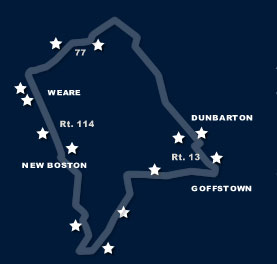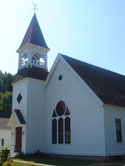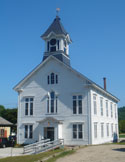 |
New BostonExploring the BywayThe General John Stark Scenic Byway is a closed loop route connecting the towns of Goffstown, Dunbarton, Weare and New Boston, New Hampshire. |
New Boston
(updated 6/27/13)
The land that is today known as New Boston was granted to John Simpson and 52 others by the Great and General Court or Assembly on January 14, 1736. Simpson and the other 52 settlers who were originally from Boston suggested naming the new township “New Boston” and was later applied for the first time by the proprietors on April 16, 1751.
By 1740, on what was called Pine Plain, there had been 60 buildings erected including houses, a sawmill and a meeting house which was later destroyed by fire.
By September 25, 1756 a first census recorded 59 persons within the New Boston Township, 215 cleared acres, 32 dwellings, 2 camp houses, 1 barn, 1 sawmill, 1 grain mill, a dam, and 6 frames not enclosed. A second census was conducted in 1820. At this time New Boston had a population of 1,686 and the town had grown substantially to 16 school districts, 14 schoolhouses, 1 tavern, 3 stores, 25 sawmills, 6 grain mills, 2 clothing mills, 2 carding mills, 1 bark mill and 2 tanneries.
On May 12, 1887 the “Great Village Fire” started at noon from a spark from Abram Wason’s cooper shop. The fire destroyed nearly 40 buildings, as well as many permanent records kept for the town. The destroyed papers have resulted in gaps in New Boston’s town history.
In 1893, the Boston and Maine Railroad came to New Boston, stopping at Parker’s Station, the Depot, and Gregg’s Mill. J. Reed Whipple was the man responsible for getting the railroad through New Boston so that it could provide his hotels in Boston with fresh produce. The railroad operated through the mid-1970’s before it was abandoned. Today, the old railroad tracks serve as a walking path.
 A 1,415-pound Paul Revere bell tops the Community Church and is rung at the beginning of each service, calling locals to worship; the bell is one of 16 known in New Hampshire. The bell was purchased in 1826 and installed in the church in 1892. This Presbyterian Church replaced a chapel that was destroyed in a fire in 1887.
A 1,415-pound Paul Revere bell tops the Community Church and is rung at the beginning of each service, calling locals to worship; the bell is one of 16 known in New Hampshire. The bell was purchased in 1826 and installed in the church in 1892. This Presbyterian Church replaced a chapel that was destroyed in a fire in 1887.
Made in Paris in 1743, the brass four-pound Molly Stark Cannon was captured by General Stark’s troops at the Battle of Bennington. Nicknamed “Old Molly,” the cannon was presented by Stark to the New Boston Artillery Company by Stark in recognition for its part in the battle. Today it is part of the New Boston Historical Society collection.
The Molly Stark Historical Marker was placed on the common by residents of New Boston in 1984 to present and explain the historic importance of the Molly Stark Cannon.
Davis Scenic Drive off Route 13 is a 3.3-mile country road dedicated to the memory of local hero Ronald Charles Davis, who was killed in the Vietnam War in 1970. There is a route marker at each end of the drive.
One can still view the New Boston Railroad Depot on Depot Street where a roundtable was originally built to reverse an engine's direction. Currently, on the town common, one sees the Old Fire House, built in 1889. At one time it housed a horse-drawn pump engine and later, actual fire engines. The station had to be remodeled to accommodate the large fire engines, resulting in the doors being moved from the front of the building to the side. The renovation cost $2,000. Today it houses the New Boston Recreation Department.
 New Boston Town Hall (at left) was built after a fire in 1887 destroyed the lower town hall. The town hall was and still is the meeting place for the Joe English Grange No. 53. which was formed in 1875. It is the current location of the town offices.
New Boston Town Hall (at left) was built after a fire in 1887 destroyed the lower town hall. The town hall was and still is the meeting place for the Joe English Grange No. 53. which was formed in 1875. It is the current location of the town offices.
Hillsborough County Agricultural Fairgrounds is the home of the annual Hillsborough County Fair, held each September.
Interesting sites and events to look for:
- A classic New England town common with its picturesque gazebo forms the core of the surrounding New Boston Town Hall, the old fire house and Historical Society. The common is a meeting ground for locals and travelers alike and hosts concerts on the common, a weekly farmers' market, festivals and even weddings.
- The rambling Piscataquog River runs along the north side of Route 13. Numerous vehicle pull-offs along the route provide views of beautiful stone walls, state and local forests and access to favorite fishing spots.
- Historic concrete barns on Route 77 bring New Boston's farming history to life.
- Hillsborough County Youth Center grounds hosts the town's largest events of the year: the 4th of July Celebration (with parade through town before the "party") and the Hillsborough County Fair. Exhibitions, races and other events are continually happening here.
- The scenic New Boston Rail Trail takes the hiker from New Boston to Goffstown as renewed efforts are happening to improve its condition. Stop for a rest at Lang Station, a drop-off and upload stop for the original railway.
Route 13 returns to Goffstown.
FUNDED BY

|